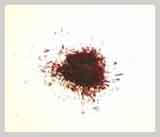Please join our email list to be notified of the book being published and other illumination related topics.

Unlocking
the Secrets of
Medieval Painters and Illuminators
ABOUT THE PIGMENT ALMANAC:
The Pigment Almanac is an exciting and innovative resource for contemporary artists, conservators and art historians covering more than 96 pigment of historical and contemporary significance. Each meticulously researched entry has detailed and well documented historical and technical information along with hands-on, real life experiences and tips for using a pigment.
EXCERPT:
Saffron
Contemporary Names: Saffron yellow, saffron.
Ancient, Medieval, and Obsolete Names: Saffron yellow, saffron.
Nomenclature: From the Arabic za’faran meaning yellow.[1]
Entomological / Chemistry / Botanical Name: Crocus sativus, dyestuff: crocetin; other sources of crocetin: the fruit of the cape jasmine (Gardenia florida L.); the leaves of Gunari or Indian mahogany (Cedrela toona Roxb.); the flowers of the tree of sorrow (Nyctanthes abor-tristis L.).
Color Index Name and Number: NY 6.
First Known Written Documentation: Ancient: The Papyrus Ebens (1550 BCE),[2] Dioscorides (1st century), Leyden Papyrus X (3rd century); Medieval: Lucca MS (c. 600).
First Use / Last Use: In use from ancient times / 19th century. (Very limited use today.)

History: Saffron is collected from the fall-blooming Crocus sativus, which is quite similar in appearance to the Crocus vernis which announces the first bloom of spring each year. Care must be taken not to mistake these two flowers. The Crocus sativus has purple or white flowers with orange-red stigmas. These stigmas are harvested and dried to become saffron.
SSaffron Threads
Saffron has a rich and ancient history. It was use by the ancient Sumerians as a perfume and a medicine. [3] It has also been used since ancient times as a dye and to color and flavor foods. Saffron was grown in Europe during the medieval period. In England, a town at the center of the English saffron harvest changed its name from Chipping Walden to Saffron Walden.[4] S. Audemar (late 13th to 14th centuries) mentions that it grew in France as well but notes that it was of poor quality.[5]
Medieval artists used saffron extensively in recipes to imitate gold leafing. It was also commonly mixed with blues to get a wider range of green tones. However, because saffron was so fugitive, it sometimes bleached out completely leaving blue grass or trees behind.[6] Many, many verdigris recipes suggest tempering the verdigris with saffron to achieve a warmer green tone. It has been proven that the dyestuff in saffron, crocetin, has protective anti-oxidative properties. Although it has not been proven whether these protective properties were known in medieval Europe, they were known to medieval Islamic lands. A 16th century Persian manuscript recommends adding saffron to verdigris to protect from verdigris’s acidic nature.[7] Most recipes for saffron paint were extremely simple, instructing the artist to soak the saffron strands overnight in glaire. Saffron’s use as a pigment effectively ended with the advent of cheaper lightfast synthetics.
Technical Information
Studio Notes: Great for glazing and details, but because of its fugitive nature, it not recommended for use outside of books except as an antioxidant. Store only in a dry form, liquid saffron will darken over time. (See ‘Pigment Recipes: Solution’.)
Source: Plant.
Color Range: Warm orange to bright yellow.
Compatibility with Other Pigments: Excellent. Best color in glaire. (See ‘Binder Interaction Chart’ in ‘Paintmaking Chapter’.)
Opacity: Very low.
Lightfastness: Low, especially precipitated on chalk. (See ‘Lightfastness Chart’ in ‘Pigment Chapter’.)
Fastness to Media: Excellent.
Toxicity: Considered non-toxic and used for centuries in foods.
A PARTIAL LIST OF OTHER PIGMENTS COVERED:
Alizarin crimson,
Azurite,
Bister,
Black walnut,
Blue & Green Bice,
Bone black,
Bone white,
Brazilwood,
Brown Earths,
Cadmium red,
Cadmium Yellow,
Celendine,
Cerulean blue,
Chrome Green,
Chrysocolla,
Cinnabar,
Cinquasia Gold,
Cobalt blue,
Cobalt green,
Cobalt turquoise,
Cobalt violet,
Cochineal,
Dioxine Violet,
Dragon's blood,
Eggshell,
Egyptian blue,
Emerald green,
Folium,
Fustic,
Gamboge,
Green Earths,
Hematite, Indian yellow,
Indigo,
Irgazine red,
Iris green,
Ivory Black,
Kermes,
Lac,
Lady's bedstraw,
Lamp black,
Lead tin yellow,
Leaf green,
Logwood,
Madder,
Malachite,
Manganese Blue,
Manganese violet,
Masticot,
Medieval Copper Blues,
Naples Yellow,
Natural Chalk,
Orchil,
Orpiment,
Pearl luster,
Phthalo blue,
Phthalo green,
Prussian blue,
Quinacridone red, Realgar,
Red earths,
Red lead.
Sap green,
Sepia, Siennas,
Silver blue,
Smalt,
Titanium white,
Turmeric,
Ultramarine-Natural & Synthetic,
Umbers,
Vandyke Brown,
Verdigris,
Vermillion,
Vine black,
Viridian green,
Vivianite,
Weld,
White lead,
Woad,
Yellow Earths,
Zinc white
View Other Chapters From Lapis & Gold:
Contact us for more information
(c) 2006-9
Sybil Archibald &
Karen Gorst
All material on this website is copyrighted and may not be used without
permission.
